Kowloon Attractions and top things to see Guide
Lei Cheng Uk Han Tomb
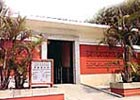 The
Lei Cheng Uk Han Tomb Museum is located at Tonkin Street in Sham Shui
Po, Kowloon. It is a five-minute walk from the Cheung Sha Wan MTR Station.
The Museum is composed of an Eastern Han dynasty brick tomb and an exhibition
gallery. The tomb was discovered in 1955 when the Government was leveling
a hill slope at the Lei Cheng Uk Village for the construction of resettlement
buildings. The
Lei Cheng Uk Han Tomb Museum is located at Tonkin Street in Sham Shui
Po, Kowloon. It is a five-minute walk from the Cheung Sha Wan MTR Station.
The Museum is composed of an Eastern Han dynasty brick tomb and an exhibition
gallery. The tomb was discovered in 1955 when the Government was leveling
a hill slope at the Lei Cheng Uk Village for the construction of resettlement
buildings.
According to the structure, calligraphy and content of the inscriptions
on tomb bricks and tomb finds, it is believed that the tomb was built
in the Eastern Han dynasty (25 - 220 AD). The tomb was declared as a gazetted
monument in 1988 and is preserved permanently thereafter. Though it is
closed to public for conservation reasons, visitors can still have a glimpse
of the interior of the tomb through the glass panel at the Entrance Passage.
Flagstaff House Museum of Tea Ware
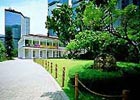 Flagstaff
House of Museum of Tea Ware specializes in housing, studying and displaying
teaware. The core of its collection is donated by Dr. K.S. Lo, among which
the Yixing teapot is the most representative. The museum building was
originally the office and residence of the Commander of British Forces
built in the 1840s. It was converted to the now Flagstaff House Museum
of Tea Ware in 1984, with an extension of new wing, The K.S. Lo Gallery,
built in 1995. Besides exhibitions, the Flagstaff House Museum of Tea
Ware also holds regular demonstrations and lecture programmes for promoting
Chinese tea drinking culture. Flagstaff
House of Museum of Tea Ware specializes in housing, studying and displaying
teaware. The core of its collection is donated by Dr. K.S. Lo, among which
the Yixing teapot is the most representative. The museum building was
originally the office and residence of the Commander of British Forces
built in the 1840s. It was converted to the now Flagstaff House Museum
of Tea Ware in 1984, with an extension of new wing, The K.S. Lo Gallery,
built in 1995. Besides exhibitions, the Flagstaff House Museum of Tea
Ware also holds regular demonstrations and lecture programmes for promoting
Chinese tea drinking culture.
Kowloon Walled City Park
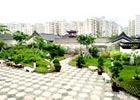 Old
Kowloon Walled City. It is a wonderfully landscaped park with archeological
digs and reconstructions of traditional Chinese walled house enclosures.
In 1898 Great Britain leased the New Territories from China for 99 years.
Technically Hong Kong did not have to be returned to China, just the New
Territories. In this leasing agreement there the Old Kowloon Walled City
was an anomaly as it was a fortified, Chinese garrison town that was beyond
the original boundary street and was excluded from the agreement and claimed
by the Chinese as their territory. Old
Kowloon Walled City. It is a wonderfully landscaped park with archeological
digs and reconstructions of traditional Chinese walled house enclosures.
In 1898 Great Britain leased the New Territories from China for 99 years.
Technically Hong Kong did not have to be returned to China, just the New
Territories. In this leasing agreement there the Old Kowloon Walled City
was an anomaly as it was a fortified, Chinese garrison town that was beyond
the original boundary street and was excluded from the agreement and claimed
by the Chinese as their territory.
Lei Yue Mun
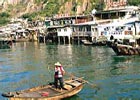 A
short bus or taxi ride beyond the Kwun Tong MTR station is the village
of Lei Yue Mun. Partly built on harborside stilts, the old village - a
former lair of pirates and smugglers - is a seafood-lover's offbeat destination.Visitors
can wander at will along covered plankways, purchase their own live seafood
from the many market stalls, and take it into nearby restaurants to be
cooked according to their own specifications. Lei Yue Mun is an extraordinary
experience. The nearby Eastern Harbour Crossing (opened in 1989) links
the eastern parts of Kowloon with Hong Kong Island, but Lei Yue Mun remains
a raffishly rural backwater of "old" Hong Kong. A
short bus or taxi ride beyond the Kwun Tong MTR station is the village
of Lei Yue Mun. Partly built on harborside stilts, the old village - a
former lair of pirates and smugglers - is a seafood-lover's offbeat destination.Visitors
can wander at will along covered plankways, purchase their own live seafood
from the many market stalls, and take it into nearby restaurants to be
cooked according to their own specifications. Lei Yue Mun is an extraordinary
experience. The nearby Eastern Harbour Crossing (opened in 1989) links
the eastern parts of Kowloon with Hong Kong Island, but Lei Yue Mun remains
a raffishly rural backwater of "old" Hong Kong.
Wong Tai Sin Temple
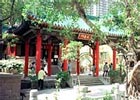 Named
after a shepherd boy who is believed to have had mystical healing powers,
this temple complex is a gloriously colourful spectacle founded on the
lower slope of the Kowloon Hills over half a century ago. Crucial family
decisions are often resolved by reference to the deity, and the temple's
host of fortune-tellers have helped to make this Hong Kong's most popular
temple. The sacred grounds are most busy during Chinese New Year and on
Wong Tai Sin's birthday, on the 23rd day of the 8th lunar month. The temple
gives its name to the nearby MTR station. Named
after a shepherd boy who is believed to have had mystical healing powers,
this temple complex is a gloriously colourful spectacle founded on the
lower slope of the Kowloon Hills over half a century ago. Crucial family
decisions are often resolved by reference to the deity, and the temple's
host of fortune-tellers have helped to make this Hong Kong's most popular
temple. The sacred grounds are most busy during Chinese New Year and on
Wong Tai Sin's birthday, on the 23rd day of the 8th lunar month. The temple
gives its name to the nearby MTR station.
Just north of Tsim Sha Tsui is lively Yau Ma Tei. This area used to
house a bustling typhoon shelter, which was relocated to give way to the
West Kowloon Reclamation Project. This district is full of specialty shops
and street markets which provide fascinating insights into traditional
Chinese lifestyles.
Tin Hau Temple
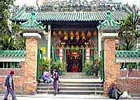 Go
straight into Wing On Street from the ferry pier and you will find Tin
Hau Temple. Tin Hau Temple was built in 1798 and was renovated in 1876
while the centuries-old architecture was still retained. Inside the temple,
there is a 8-feet whale bone which was dedicated to Tin Hau 100 years
ago by the fishermen. Go
straight into Wing On Street from the ferry pier and you will find Tin
Hau Temple. Tin Hau Temple was built in 1798 and was renovated in 1876
while the centuries-old architecture was still retained. Inside the temple,
there is a 8-feet whale bone which was dedicated to Tin Hau 100 years
ago by the fishermen.
Between Market and Public Square Sts, a block or two north of the Jade
Maket, is a good Sized temple dedicated to Tin Hau, the God of Seafarers.
To the right, as you face the main temple, is a long row of fortune-tellers.
The temple complex also houses an altar dedicated to Shing Won (God Oof
the City) and To Tei (God of the Earth). The temple is open daily from
8 am to 6 pm.
Jade Market
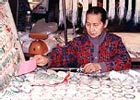 Located
on the junction of Kansu and Battery streets, this casual, open-air market
boasts more than 400 stall owners. To Chinese, jade has great spiritual
value. When carved into certain shapes, it can represent wealth (deer),
good fortune (tiger) or power (dragon). Don't buy expensive jade unless
you know what you are doing. Starting at 10 a.m. it runs till about 3:30
p.m. daily. The best time to go is in the morning. Located
on the junction of Kansu and Battery streets, this casual, open-air market
boasts more than 400 stall owners. To Chinese, jade has great spiritual
value. When carved into certain shapes, it can represent wealth (deer),
good fortune (tiger) or power (dragon). Don't buy expensive jade unless
you know what you are doing. Starting at 10 a.m. it runs till about 3:30
p.m. daily. The best time to go is in the morning.
Many beautiful and distinctive pieces of all shapes and sizes can be
found in Yau Ma Tei's Jade Market. Located at the intersection of Kansu
and Battery Streets, it will be on your right just past the Yau Ma Tei
police station as you walk west on Kansu street from the vicinity of the
Majestic Hotel and King's Park.
Temple Street Night Market
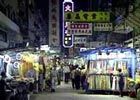 The
Temple Street Night Market comes alive after 6:00 p.m. and offers an wide
range of inexpensive items mostly for men, from jeans and t-shirts to
lighters and shoes. There are also dozens of fortune tellers, Chinese
opera performers, and scores of food sellers offering traditional Chinese
cooked snacks. The
Temple Street Night Market comes alive after 6:00 p.m. and offers an wide
range of inexpensive items mostly for men, from jeans and t-shirts to
lighters and shoes. There are also dozens of fortune tellers, Chinese
opera performers, and scores of food sellers offering traditional Chinese
cooked snacks.
Very popular night market a short walk from the Jordan Road MTR stop,
the best time to go is after 8:00 p.m.
Mong Kok lies a few blocks to the north. Although parts of the district
have been modernized -- it is the site of one of Hong Kong's ambitious
redevelopment master plans -- it remains a cheerfully crowded community
and a hive of shopping activity.
Ladies Market
This daytime equivalent to the Temple Street Night Market is on Tung
Choi Street. Open daily from noon to 10:30pm.
Bird Garden
At this lively market recently relocated to a Chinese-style bird garden
on Yuen Po Street, hundreds of caged birds are the songful stock-in-trade.
Opens daily from 7am - 8pm.
Gold Fish Market
On Tung Choi Street south of Prince Edward Road West, this market is
where fish fanciers hook good deals on everything from intricate underwater
furniture to fluorescent fish. Most shops open from 10am - 6pm.
Flower Market
Located on Flower Market Road near Prince Edward Road West, colorful
blooms from all over the world are sold both wholesale and retail. Open
10am - 6pm.
|

